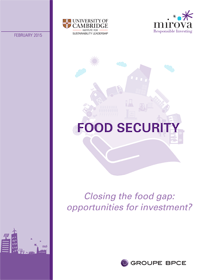15 April 2015 – ‘Food Security: Closing the food gap: opportunities for investment?’ investigates three particular categories of food security solutions that can actively contribute to sustainable food security. A focus on postharvest losses illustrates the differing profiles of solutions in developed and developing countries. Biotechnology, especially the area of GM seeds, is an issue that inspires confusion and hot debate. Water management was selected because it is closely tied to climate change, and critical to human health.
The report was prepared by Mirova, a subsidiary of Natixis Asset Management, in partnership with the ESG research and analysis firm Sustainalytics, and with specialist contributions from experts across the University of Cambridge including those involved in Cambridge’s Global Food Security strategic initiative.
The research forms part of a partnership between Natixis and the University of Cambridge Institute for Sustainability Leadership (CISL) to promote sustainable investment and encourage European and international finance professionals to adopt a more responsible behaviour.
The partnership comprises Natixis’s support for the CISL-convened Investment Leaders Group as well as a series of research and joint publications.
Find our more about our work with Natixis.




